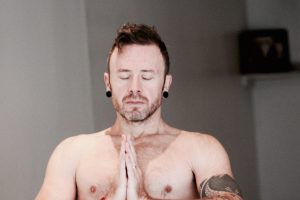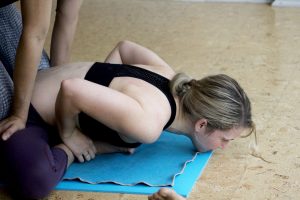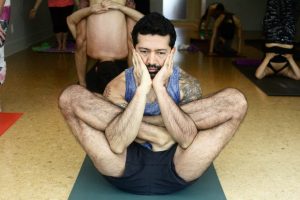I remember the first yoga class I ever took. Disclaimer – it wasn’t an Ashtanga class. I had never done yoga before, and I had no idea what it was all about. My friend and I were just told to go into the room, lay down on our mats and wait for the teacher’s instructions. When the teacher finally walked in, she had the stereotypical “yoga teacher” voice. You know the one I’m talking about? She started off the class by making this gentle, yet dramatic “mmm…” sound, and then began leading us through the practice. She encouraged us to forget about our worries for the remaining 60 minutes and to relax. Her words were something along the lines of “Let your body and your worries melt into the mat…” That image always stayed with me, and it was actually really relaxing.
But for years, this is what I thought yoga was.
I thought yoga was this thing you did to relax and forget about all your troubles. I kind of thought of it as a distraction from all the bad things going on in my life. A place where I could go to forget. So that’s what I did – I went to yoga to escape reality, and indulge myself in the nice words the teachers said as they guided us for 60 odd minutes. It seemed… fluffy. And truthfully at that time in my life, fluffy was great!
After years of going to different yoga classes at various non-traditional studios, and immersing myself in all the fluffiness, I stumbled into AYCT and met David Robson. The exact opposite of fluffy. I mean, he’s funny… but absolutely, positively not fluffy.

Under David’s guidance, I began practicing Mysore style Ashtanga 6 days a week
It was a completely different experience. All of a sudden there was no one telling me what to do with my mind. No one telling me to allow my worries to melt into my mat. No distraction. It was just me, my breath and my mat. Rather than my thoughts and worries melting away in some idealistic manner, they were slowly but surely making their way into the forefront of my consciousness. So instead of “relaxing, and escaping my worries,” I was now forced to face them head-on.
While part of me resisted this, an equal part of me knew that something profound and important was happening. I began to realize that the practice of yoga was not was not about escaping my thoughts and feelings. It was the practice of learning how to be with them. It was the practice of learning how to sit with and lean into discomfort. Ashtanga Yoga is ultimately the practice of equanimity.

Equanimity can only be found in fucked up places – David Robson
Now let’s get clear – equanimity isn’t just some nice concept or something you can read in a book and get. You can’t learn how to sit with your feelings, or discomfort just by reading Deepak Chopra or Thich Nhat Hanh. It’s a place to start, but ultimately you have to do the work. And I hate to be the one to break it to you, but the work isn’t easy.
The Ashtanga practice is designed to bring you to your edge each and every day. You show up 6 days a week, and invariably you are met with something that challenges you. Maybe it’s a pose you can’t quite get. Maybe you’re having a disagreement with a partner, and it’s all you can think about throughout your practice. Perhaps something from your childhood or an unresolved issue suddenly decides to make its way into your mind in the middle of kapotasana.
This practice isn’t easy, but it’s worth it
Let’s be honest, it’s easy to be equanimous when the world around you is still, and calm, or when you’re already feeling great. But when you’re confronted with your humanity, your ego, or your limitations in the middle of a physically uncomfortable pose, it gets a little more difficult. When you commit to showing up 6 days a week, you commit to noticing your discomfort each and every day.
There is a depth about Ashtanga that is far greater than showing up on your mat and letting your worries melt away. It’s not so much about pushing sensations away, and distracting yourself with idealistic notions of calmness – it’s much more about learning to lean into the discomfort. It’s about showing up every day and allowing whatever comes up to be there. Focusing on your breath in spite of your worries, or fears or physical discomfort. It’s about allowing those sensations to be there, exactly as they are, without changing them.

The way out of suffering is through suffering – Ekhart Tolle
We’re more than often taught to look on the bright side, or be positive when coming face to face with a challenging emotion or uncomfortable situation, rather than encouraged to sit with it. But Ashtanga demands that you sit with it. This practice doesn’t let you run from your humanity, it asks that instead, you be with it. Ashtanga is the space for you to observe, and sit with the ugly emotions and sensations that come up. It is the space where your humanity shows up.
It’s sort of funny when I look back. To think that I thought a yoga class here and there would make all my worries melt away. I mean, if all anyone needed was someone in a soothing voice to have your worries melt away, everyone would do it. But it’s not that easy. It takes work. Real work, every single day. There is something deeply profound about showing up 6 days a week and spending 90+ minutes with yourself. You get to know yourself intimately. You get a glimpse of your light, but ultimately you come face to face with your darkness. And I know that sounds bleak, but I promise it’s actually really, really beautiful. It’s easy to be with your light, but what’s far more daring is to sit with your darkness.
So the worries, and discomfort haven’t melted away. They’re still there. They come up almost every day, and I can bet they aren’t going away. But that isn’t the point. The point isn’t to make them go away. The point is to learn how to be with those worries and breathe anyways.

